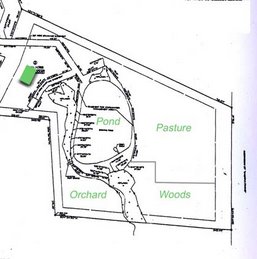Take yesterday, for instance. A white, duck-like bird was swimming about, & diving down for 30 seconds or more at a time. A quick perusal of the Audobon guide led me to identify it as a Common Merganser, but I didn't have much time to spend watching it. This morning, there he was again, as Chris and I were doing the leisurely coffee-sipping thing. "I don't
 think it's a Merganser," said Chris, citing its dark beak (Merganser beaks are orange). Out came the bird books and binoculars. Just as we'd get a good look at him, the little guy would dive underwater, and emerge elsewhere. We eventually trained the telescope on him (oddly enough, we use it much more for bird-watching than star-gazing!), and identified the trademark that gives the Common Goldeneye its name. This is a new addition to our Bird List! Meanwhile, as all this was unfolding, not one, but two Great Blue Herons paid us a visit as well. Revelling in our good fortune, we watched the pond for a while and then the Goldeneye suddenly took off, flying over the fields. The herons left a bit later.
think it's a Merganser," said Chris, citing its dark beak (Merganser beaks are orange). Out came the bird books and binoculars. Just as we'd get a good look at him, the little guy would dive underwater, and emerge elsewhere. We eventually trained the telescope on him (oddly enough, we use it much more for bird-watching than star-gazing!), and identified the trademark that gives the Common Goldeneye its name. This is a new addition to our Bird List! Meanwhile, as all this was unfolding, not one, but two Great Blue Herons paid us a visit as well. Revelling in our good fortune, we watched the pond for a while and then the Goldeneye suddenly took off, flying over the fields. The herons left a bit later.Lately we've also been seeing a lot of the Eastern Bluebird, especially along the path leading back to the pasture. And not long ago, we welcomed another addition to our Bird List: the Common Grackle. They are very common indeed; I'm surprised we hadn't spotted one before. I wasn't moved to post about them at the time, but might as well acknowledge the Common Grackle here as part of our Christmas Birding Bonus!






















.jpg)
















